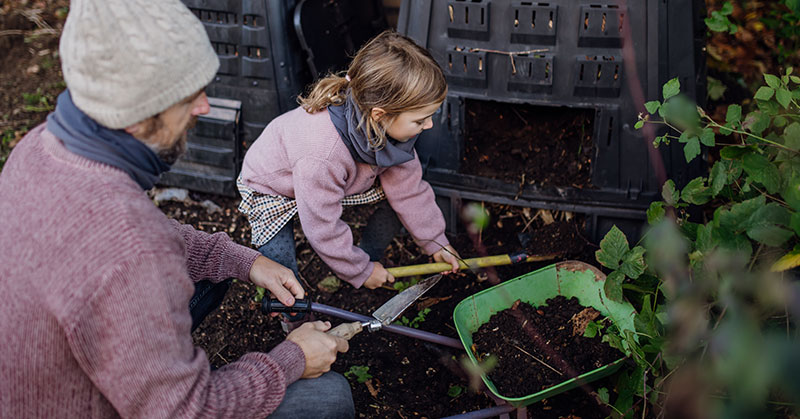Turning compost without a pitchfork is entirely feasible and can be done using various alternative methods. Tools like a garden cultivator or a shovel can effectively aerate your compost pile, breaking up clumps and introducing necessary oxygen. For those seeking a more hands-off approach, compost tumblers offer an easy solution, allowing you to turn the compost by simply rotating the drum. Layering your compost pile is another no-turn technique, where materials are added in specific layers to naturally decompose without the need for physical turning. Additionally, employing worms in vermicomposting can also help in breaking down organic matter without the need for manual turning.
As you delve into our detailed guide, you’ll discover not just one, but multiple innovative ways to maintain a healthy and thriving compost pile without the traditional pitchfork. From easy-to-use compost tumblers to the wonders of worm composting, each method is explored with practical tips and insights.
Whether you’re an urban gardener with limited space or someone looking to simplify their composting routine, our guide provides valuable knowledge and tips to enhance your composting experience.
So, let’s turn that pile into black gold with ease and efficiency, exploring the world of alternative compost turning methods that are both effective and accessible to all.
Garden Forks or Cultivators
While a pitchfork might be the traditional tool for turning compost, a garden fork or cultivator can be equally effective. These tools are especially useful for smaller compost piles. They provide enough leverage to turn the material, allowing air to penetrate and speed up the composting process.
Shovels and Spades
For many gardeners, a shovel or spade is a readily available alternative. They work well for flipping and mixing compost. The key is to dig deep into the pile and turn the material over, ensuring that the compost at the edges is brought to the center.
Hands-On Approach
For those who don’t mind getting a bit dirty, using your hands can be a surprisingly effective method. Wear a pair of durable gloves and manually turn and mix the compost. This method gives you the opportunity to feel the texture of the compost and identify any issues like dry spots or clumping.
Compost Aerator Tools
Compost aerator tools are designed specifically for this purpose. They usually have a handle and a set of wings or tines at the bottom. You simply push the tool into the compost, twist, and pull it out, which mixes and aerates the pile without the need for heavy lifting.
Barrel or Tumbler Systems
For a more hands-off approach, consider investing in a compost tumbler. These barrel-like containers can be filled with compost material and then easily turned with a handle. This method is clean, easy, and ideal for those with physical limitations or smaller garden spaces.
Layering Technique
Instead of turning, you can layer your compost. Start with a layer of coarse material, like straw or twigs, for aeration. Then add layers of green and brown materials alternatively. As you add new layers, the weight and natural settling will help to mix and aerate the lower layers.
Rolling the Bin
If you have a movable compost bin, you can literally roll it on the ground to mix the contents. This method is best for lighter, smaller bins. It’s a simple and effective way to turn the compost without any tools at all.
Using Water for Aeration
In some cases, simply adding water can help to aerate your compost. The water helps to break down dense materials and creates channels for air to flow through. However, be cautious not to overwater, as too much moisture can lead to anaerobic conditions.
Conclusion
Turning compost without a pitchfork is not only possible but can be an enjoyable part of your gardening routine. Whether you prefer a hands-on approach or a more automated system, there are plenty of methods to ensure your compost gets the aeration it needs. Experiment with different techniques to find what works best for you and your garden.
FAQs on How to Turn Compost without a Pitchfork
Q: Can I use a garden rake to turn my compost?
A: Yes, a garden rake can be used for turning and spreading compost, especially in smaller or less compacted piles.
Q: Is it possible to turn compost with just my hands?
A: While possible, turning compost by hand can be messy and inefficient. It’s better to use gloves and a tool like a small shovel or cultivator.
Q: How often should I turn my compost using a tumbler?
A: For a compost tumbler, aim to turn it every 2-3 days to maintain aeration and speed up the composting process.
Q: Can adding water help with turning compost?
A: Adding water can help maintain moisture levels but doesn’t replace turning. Moisture aids in the decomposition process, but physical turning is necessary for aeration.
Q: Are there any electric tools to help with turning compost?
A: Electric compost mixers are available, though not widely used. They can be helpful for larger composting operations or for those with physical limitations.
Q: How do I know if my compost is well-aerated without turning it?
A: Well-aerated compost should not have a bad odor and should be decomposing evenly. If your compost is smelly or stagnant, it likely needs more aeration.
Q: Can I use a pitchfork alternative for a large compost pile?
A: Yes, larger compost piles might require tools like a cultivator or a compost aerating tool, which can handle more volume than a standard garden tool.




